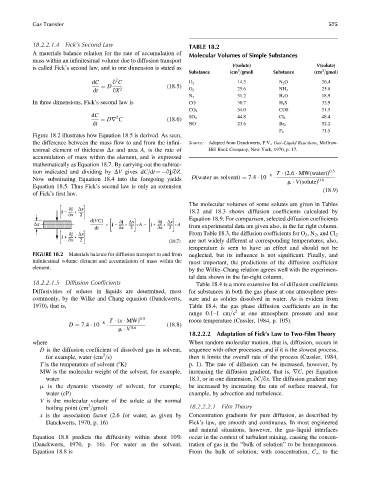Page 620 - Fundamentals of Water Treatment Unit Processes : Physical, Chemical, and Biological
P. 620
Gas Transfer 575
18.2.2.1.4 Fick’s Second Law TABLE 18.2
A materials balance relation for the rate of accumulation of Molecular Volumes of Simple Substances
mass within an infinitesimal volume due to diffusion transport
V(solute) V(solute)
is called Fick’s second law, and in one dimension is stated as
3
3
Substance (cm =gmol) Substance (cm =gmol)
2
dC q C H 2 14.3 N 2 O 36.4
¼ D (18:5) 25.6 25.8
dt qX 2 O 2 NH 3
31.2 H 2 O 18.9
N 2
In three dimensions, Fick’s second law is CO 30.7 H 2 S 32.9
34.0 COS 51.5
CO 2
dC 2 44.8 48.4
¼ Dr C (18:6) SO 2 Cl 2
dt NO 23.6 Br 2 52.2
71.5
F 2
Figure 18.2 illustrates how Equation 18.5 is derived. As seen,
the difference between the mass flow to and from the infini- Source: Adapted from Danckwerts, P.V., Gas–Liquid Reactions, McGraw-
tesimal element of thickness Dx and area A, is the rate of Hill Book Company, New York, 1970, p. 17.
accumulation of mass within the element, and is expressed
mathematically as Equation 18.7. By carrying out the subtrac-
tion indicated and dividing by DV gives dC=dt ¼ qj=qZ. 8 T (2:6 MW(water)) 0:5
Now substituting Equation 18.4 into the foregoing yields D(water as solvent) ¼ 7:4 10 0:6
m V(solute)
Equation 18.5. Thus Fick’s second law is only an extension
(18:9)
of Fick’s first law.
The molecular volumes of some solutes are given in Tables
∂j Δx
j – 18.2 and 18.3 shows diffusion coefficients calculated by
∂x 2
d(VC) ∂j Δx ∂j Δx Equation 18.9. For comparison, selected diffusion coefficients
Δx = j – A – j + A from experimental data are given also, in the far right column.
dt ∂x 2 ∂x 2
∂j Δx From Table 18.3, the diffusion coefficients for O 2 ,N 2 , and Cl 2
j +
∂x 2 (18.7) are not widely different at corresponding temperatures; also,
temperature is seen to have an effect and should not be
FIGURE 18.2 Materials balance for diffusion transport to and from neglected, but its influence is not significant. Finally, and
infinitesimal volume element and accumulation of mass within the most important, the predictions of the diffusion coefficient
element.
by the Wilke–Chang relation agrees well with the experimen-
tal data shown in the far-right column.
18.2.2.1.5 Diffusion Coefficients Table 18.4 is a more extensive list of diffusion coefficients
Diffusivities of solutes in liquids are determined, most for substances in both the gas phase at one atmosphere pres-
commonly, by the Wilke and Chang equation (Danckwerts, sure and as solutes dissolved in water. As is evident from
1970), that is, Table 18.4, the gas phase diffusion coefficients are in the
2
range 0.1–1cm=s at one atmosphere pressure and near
T (x MW) 0:5 room temperature (Cussler, 1984, p. 105).
8
D ¼ 7:4 10 (18:8)
m V 0:6
18.2.2.2 Adaptation of Fick’s Law to Two-Film Theory
where When random molecular motion, that is, diffusion, occurs in
D is the diffusion coefficient of dissolved gas in solvent, sequence with other processes, and if it is the slowest process,
2
for example, water (cm =s) then it limits the overall rate of the process (Cussler, 1984,
T is the temperature of solvent (8K) p. 1). The rate of diffusion can be increased, however, by
MW is the molecular weight of the solvent, for example, increasing the diffusion gradient, that is, rC, per Equation
water 18.3, or in one dimension, qC=qx. The diffusion gradient may
m is the dynamic viscosity of solvent, for example, be increased by increasing the rate of surface renewal, for
water (cP) example, by advection and turbulence.
V is the molecular volume of the solute at the normal
3
boiling point (cm =gmol) 18.2.2.2.1 Film Theory
x is the association factor (2.6 for water, as given by Concentration gradients for pure diffusion, as described by
Danckwerts, 1970, p. 16) Fick’s law, are smooth and continuous. In most engineered
and natural situations, however, the gas–liquid interfaces
Equation 18.8 predicts the diffusivity within about 10% occur in the context of turbulent mixing, causing the concen-
(Danckwerts, 1970, p. 16). For water as the solvent, tration of gas in the ‘‘bulk of solution’’ to be homogeneous.
Equation 18.8 is From the bulk of solution, with concentration, C o , to the

